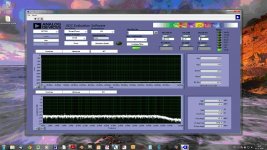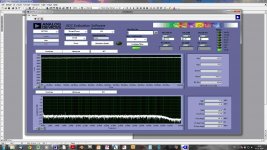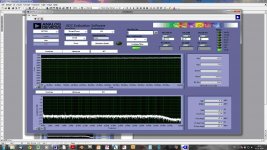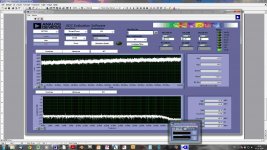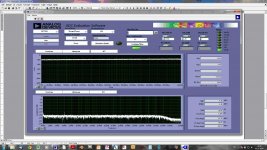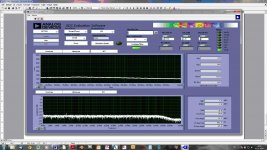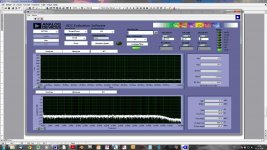Hi Nuuk,
No I'm not - actually, I can see that I didn't read your post in detail and so missed the link to the charger you were linking to. My apology for this - & for causing your confusion
As it is your schematic may be ok. However, there might be some timing issues with the hiface electronics - i.e. that the voltage to the HiFace electronics must be present a certain time after the USB connection is established. I don't know since I am not familiar with the specifics for the HiFace Two.
If this is interesting to you I personally - before starting - would ask someone who knows about this if the HiFace electronics will accept a USB datasignal before the supply voltages are at their full value (& survive!). Both relays and capacitors have delays so I would make sure this is the case.
Jesper
Jesper, M2Tech suggest using a separate PSU for the HiFace Two is OK so long as it is powered up before the computer.
There isn't any reason the world of electronics has yet to discover. I see this type of thing proposed all the time on audio forums and it is preposterous.
Yeah, we can build giant particle accelerators and super-sensitive detectors to confirm the existence of sub-atomic particles, but we can't explain the mysteries of USB audio, sure.
Unfortunately, some of these devices are so poorly designed one could not rule out audible issues. Since the high-end audio community seems to ignore science, a lot of hacks that would have been laughed out of other industries are racking up the sales.
I can say that the USB 2.0 built in to my laptop has a higher noise floor than the plug in USB 3.0 adaptor I bought. (I think it's a PC card type, I can't remember right now. It fits into a slot on the side of the computer.)
When I use the built in USB vs. the card USB, the noise floor in the FFT analyzer goes up for the built in USB, with the same ADC/DAC.
Guys why don't we take a page out of the medical system's manual and build these things with the different kinds of battery and do double blind tests then the arguments will be sort of "settled" At the end I listen to music and not to instruments making all weird noises. This should then more or less settle this argument. I found when I was a boy that if I had to use a torch to do fine work that the globe flickers and this was frustrating that is why there can be no real argument about noise/
And, the relevance is, you can measure the noise floor so its not some esoteric electronic gremlin that hasn't been discovered.If the data is getting through for both interfaces noproblems apart from the increased noise may affect your analogue out. If it does you have identified the problem and can solve it.
I can say that the USB 2.0 built in to my laptop has a higher noise floor than the plug in USB 3.0 adaptor I bought. (I think it's a PC card type, I can't remember right now. It fits into a slot on the side of the computer.)
When I use the built in USB vs. the card USB, the noise floor in the FFT analyzer goes up for the built in USB, with the same ADC/DAC.
I believe it, but if done correctly the system can be made to reject this.
The other day I glanced through a catalogue for car hi fi . There I read of "Super caps" that has a value of TEN Farad Now if you guys that want the super best and the lowest noise, get yourself then use two or more in parallel and then charge them while you swap tapes records or whatever then the noise should not worry you The lifespan should also be much longer than batteries. I also saw an ad for cordless soldering irons using these caps with a "Capacity left" meter built in. I am never trying to be funny or ugly just throwing a stick into the "bush" and see what you guys that know more think of the idea. Sometimes the most stupid idea is the best solution. NO PUN INTENDED!!!
Panasonic gold caps (double layer) are often used instead of batteries in commercial gear for all sorts of backup and powering options, one of the main ones was memory back up. For low voltage low current digital designs available these days they are an alternative to batteries.
problem with them is they are usually rated for VERY low voltage
Made me curious so I did a quick search
Cylindrical Super Capacitor
Put two in series to get 5.4V and 5F for $6.
@ what current?........Put two in series to get 5.4V and 5F for $6.
Do they quote a ripple current rating? Does it vary with frequency?
Does it become de-rated with temperature?
What does Imax <=1000C mean?
No datasheet link, no manufacturer!
These are probably instead of battery back up, for uA current loading.
Last edited:
And how many amps does it take to operate a couple of digital IC's, you would be surprised at the current required to operate some portable devices, and not so portable. In all commercial, mill, areospace and medical design these days there is a big onus on power consumption, and reducing it to the bare minimum. For portable devices it is a commercial requirement to maximise operating life between charges. And then there are the envoironmental requirements, and ever increasing legislation for power reduction.
Panasonic gold caps...
Panasonic gold caps...
Hi All,
A brief follow-up on Li-ion battery sound as I've had a chance to listen to a couple of different batteries lately. Those I've had a chance to listen to were Sanyo Li-ion 2200 mAh li-ion batteries and A123Systems ANR26650M1As (LiFePO4 chemistry). The Li-ion battery is rated at 3.8 VDC whereas the A123Systems nominally is a 3.3 VDC type. Both batteries were new (=unused) but came from either a computer (Sanyo) or other equipment - but unused.
My impressions with these two batteries are (tested in a DAC):
Sanyo li-ion: These batteries are, well, quiet yet have a sonic signature in that they tonally add a slight "sheen" on instruments from oboes or the like and upwards. Subjectively, when in the circuitry they contribute by "stabilizing and cleaning up the soundstage", however, they are not utterly stringent or tight in their influence on the reproduction of the music. I would say that they are slightly soft, albeit to me in a pleasant way (I haven't been able to find any specs on impedance etc. on this battery).
A123Systems LiFePO4: These batteries IMHO contribute to the sound by really stabilizing and focusing instruments. Stringent, very speedy, dynamic, taut, details, almost tonally neutral but for a slight fuzziness and "aluminum sheen" in the upper frequencies. Not as tonally nuanced as the Sanyo batteries or some other power supplies I've tried. More in the direction of dynamics (microdynamics), speed, stability - signaling some kind of unlimited power (these batteries have an inner impedance of 6 milliohms at 1 kHz).
To me a preliminary conclusion in this could be that Li-ion batteries may sound quite different albeit in both these instances they contribute to a varying degree with "silence", stability and nuance/detail.
Cheers,
Jesper
A brief follow-up on Li-ion battery sound as I've had a chance to listen to a couple of different batteries lately. Those I've had a chance to listen to were Sanyo Li-ion 2200 mAh li-ion batteries and A123Systems ANR26650M1As (LiFePO4 chemistry). The Li-ion battery is rated at 3.8 VDC whereas the A123Systems nominally is a 3.3 VDC type. Both batteries were new (=unused) but came from either a computer (Sanyo) or other equipment - but unused.
My impressions with these two batteries are (tested in a DAC):
Sanyo li-ion: These batteries are, well, quiet yet have a sonic signature in that they tonally add a slight "sheen" on instruments from oboes or the like and upwards. Subjectively, when in the circuitry they contribute by "stabilizing and cleaning up the soundstage", however, they are not utterly stringent or tight in their influence on the reproduction of the music. I would say that they are slightly soft, albeit to me in a pleasant way (I haven't been able to find any specs on impedance etc. on this battery).
A123Systems LiFePO4: These batteries IMHO contribute to the sound by really stabilizing and focusing instruments. Stringent, very speedy, dynamic, taut, details, almost tonally neutral but for a slight fuzziness and "aluminum sheen" in the upper frequencies. Not as tonally nuanced as the Sanyo batteries or some other power supplies I've tried. More in the direction of dynamics (microdynamics), speed, stability - signaling some kind of unlimited power (these batteries have an inner impedance of 6 milliohms at 1 kHz).
To me a preliminary conclusion in this could be that Li-ion batteries may sound quite different albeit in both these instances they contribute to a varying degree with "silence", stability and nuance/detail.
Cheers,
Jesper
Hi johansen,
Hmmm ... just in case you sometime in the future are inclined to reply to another post of mine I'd ask you to do so in a respectful way otherwise please don't reply. I strive to do so myself and am of the belief that respecting other peoples opinions and observations is conducive to a good atmosphere, learning and exchanging information.
Best regards,
Jesper
Hmmm ... just in case you sometime in the future are inclined to reply to another post of mine I'd ask you to do so in a respectful way otherwise please don't reply. I strive to do so myself and am of the belief that respecting other peoples opinions and observations is conducive to a good atmosphere, learning and exchanging information.
Best regards,
Jesper
I hear differences in batteries ... when I drop them in the middle of a camp fire.
Some go "pfffffttttt" , some go "bang", some "hissssssssss".
Also when I drop them from my 3 storey house attic, sound varies a lot between those who fall straight on soft ground, than those who land on brick or Portland Cement, to wood, etc.
Noisiest are those which land on a tin roof but nicest (personal opinion, others may differ) is when after some rain they land on a water filled hole.
That "splash" sends shivers all over my body.
Some go "pfffffttttt" , some go "bang", some "hissssssssss".
Also when I drop them from my 3 storey house attic, sound varies a lot between those who fall straight on soft ground, than those who land on brick or Portland Cement, to wood, etc.
Noisiest are those which land on a tin roof but nicest (personal opinion, others may differ) is when after some rain they land on a water filled hole.
That "splash" sends shivers all over my body.
Knee jerk responses and pathetic attempts at being humorous aside it is actually an interesting question from an engineering point of view.
I have yet to see (I might eventually get around to doing it myself) exhaustive research into the differences in noise from different battery types and chemistries. Typically noise measurements on batteries are only at rest or very low current draw. For me it would be interesting to the rise and fall time of noise at higher current draw, and at different charge levels. This would be interesting when for example designing a battery powered power amplifier because the battery noise at peak power could be very different that at very low power, and the noise could have a long enough fall time that you would be able to hear it when a passage of music goes from a crescendo to a very quiet part.
When people in here give the knee jerk response that you can just add more decoupling or that any amplifier design sensitive enough to shown a difference should be thrown out, they are just making uninformed inane assumptions.
For example if you design a battery powered class D power amplifier you can't just add more decoupling as that directly affects the ESL of the current loop. Typically you should design these with the smallest possible value that you can safely get away with so if one battery chemistry or type has an vastly better performance than another you can possibly get away with using smaller local decoupling cap which directly translates into lower ESL and quite possibly a better circuit lay-out as well. That would have definite measurable, and quite possibly audible, effect.
To get a tiny bit philosophical, whether or not there is a audible difference in a A-B blind test is rather irrelevant to me. Music and audible experience like so much else is not affected much by empirical values. For example, I'm pretty sure I can tell the difference between a death metal track and classical music track in a A-B blind test on any audio equipment but I'm also fairly confident that I could not tell the difference between a $2k 8W class A amp and a $20 8W class D amp on a pair of $100 bookshelf speakers in a random room in a A-B blind test (I know this because I have tested my Son of Zen amp against several cheap class D amps). I know which one I prefer though (it's the class D amps, btw) but that is a matter of personal preferences and many other factors that have nothing to do with actual audible differences but which all affect our subjective experience.
I have yet to see (I might eventually get around to doing it myself) exhaustive research into the differences in noise from different battery types and chemistries. Typically noise measurements on batteries are only at rest or very low current draw. For me it would be interesting to the rise and fall time of noise at higher current draw, and at different charge levels. This would be interesting when for example designing a battery powered power amplifier because the battery noise at peak power could be very different that at very low power, and the noise could have a long enough fall time that you would be able to hear it when a passage of music goes from a crescendo to a very quiet part.
When people in here give the knee jerk response that you can just add more decoupling or that any amplifier design sensitive enough to shown a difference should be thrown out, they are just making uninformed inane assumptions.
For example if you design a battery powered class D power amplifier you can't just add more decoupling as that directly affects the ESL of the current loop. Typically you should design these with the smallest possible value that you can safely get away with so if one battery chemistry or type has an vastly better performance than another you can possibly get away with using smaller local decoupling cap which directly translates into lower ESL and quite possibly a better circuit lay-out as well. That would have definite measurable, and quite possibly audible, effect.
To get a tiny bit philosophical, whether or not there is a audible difference in a A-B blind test is rather irrelevant to me. Music and audible experience like so much else is not affected much by empirical values. For example, I'm pretty sure I can tell the difference between a death metal track and classical music track in a A-B blind test on any audio equipment but I'm also fairly confident that I could not tell the difference between a $2k 8W class A amp and a $20 8W class D amp on a pair of $100 bookshelf speakers in a random room in a A-B blind test (I know this because I have tested my Son of Zen amp against several cheap class D amps). I know which one I prefer though (it's the class D amps, btw) but that is a matter of personal preferences and many other factors that have nothing to do with actual audible differences but which all affect our subjective experience.
Last edited:
anyone who claims to be able to hear the difference between a lead acid battery and a good low noise power supply..
should be able to hear a baby crying 2000 miles away.
Batteries have notably higher impedance than a well designed linear regulator. When we did the Regulator Bakeoff for Linear Audio, "noise" was deemed the least important subjective criteria.
Hi johansen,
Hmmm ... just in case you sometime in the future are inclined to reply to another post of mine I'd ask you to do so in a respectful way otherwise please don't reply. I strive to do so myself and am of the belief that respecting other peoples opinions and observations is conducive to a good atmosphere, learning and exchanging information.
Best regards,
Jesper
I've rarely seen such a perfect example of passive aggression.
Hi again,
Over the weekend I decided to do some noise measurements on the batteries I have (A123Systems 2.4 AH & SLA 12V/4 AH). I did the measurements using an AD7760 evaluation board - its basic noise level with the input shorted at the point where the batteries were connected is shown in the first attachment.
The AD7760 is mounted in a sealed steel cabinet which is immediately adjacent to another sealed steel cabinet in which the batteries were placed. Different resistors connected across the battery poles allowed for different current draws from the batteries. To protect the AD7760 from excessive voltage a couple of capacitors (series) and 1N914s (parallel) were placed inbetween the batteries and the AD7760 (-3 dB point 0.3 Hz).
I did the measurements at various currents from 10 mA to ~0.8 A, however, have only shown a couple of measurements as the results were virtually identical (i.e. essentially no change to the AD7760s noise floor).
Comments to the measurements:
- Given that both here in these forums (and elsewhere?) I've noticed that batteries are considered noisy the results made me check my setup so as to verify that there was not an error somewhere. And there should not be (tested with "finger touching" and an oscillator and the setup seems to work).
However, I noticed some very low frequency (VLF) fluctuations (~ 0-10 Hz that I couldn't find out where came from. They were present both with the batteries connected and the inputs to the ADC shorted where the batteries were connected. In the measurements they show up e.g. as VLF noise in the SLA 120 mA measurement. But had I made a screendump just a bit later it would not have been there (e.g. also not present in the 0.8 A SLA measurement). But I would say that it means that the VLF figures in absolute terms are indicative though the results were identical both for the ADC alone and the batteries.
- @jackinnj:
I have not read the article in Linear Audio (would very much like to, though) but notice that the A123systems battery has an impedance of 6 mohms at 1 kHz. Do regulators go much lower than this? And can you just briefly say (if you are at liberty to do so) what you found to be most significant in the linear audio test?
- I haven't measured nor seen any measurements on batteries' impedance as a function of frequency which could be very interesting as a comparison ...
- The measurements I made somehow correlate with the listening observations I have made over time: Invariably, adding batteries to a circuitry improves overall soundstage stability and sort of provides a "space" for (much) finer details and nuances. However, with the exception of the A123systems battery, powering the circuitry ONLY from batteries also appears to subjectively reduce the dynamic span ever so slightly ... To that end I currently use a low noise PSU to just "top-off" the batteries - this retains most of the qualities I note using batteries while subjectively restoring the somewhat diminished dynamics.
Best regards,
Jesper
Over the weekend I decided to do some noise measurements on the batteries I have (A123Systems 2.4 AH & SLA 12V/4 AH). I did the measurements using an AD7760 evaluation board - its basic noise level with the input shorted at the point where the batteries were connected is shown in the first attachment.
The AD7760 is mounted in a sealed steel cabinet which is immediately adjacent to another sealed steel cabinet in which the batteries were placed. Different resistors connected across the battery poles allowed for different current draws from the batteries. To protect the AD7760 from excessive voltage a couple of capacitors (series) and 1N914s (parallel) were placed inbetween the batteries and the AD7760 (-3 dB point 0.3 Hz).
I did the measurements at various currents from 10 mA to ~0.8 A, however, have only shown a couple of measurements as the results were virtually identical (i.e. essentially no change to the AD7760s noise floor).
Comments to the measurements:
- Given that both here in these forums (and elsewhere?) I've noticed that batteries are considered noisy the results made me check my setup so as to verify that there was not an error somewhere. And there should not be (tested with "finger touching" and an oscillator and the setup seems to work).
However, I noticed some very low frequency (VLF) fluctuations (~ 0-10 Hz that I couldn't find out where came from. They were present both with the batteries connected and the inputs to the ADC shorted where the batteries were connected. In the measurements they show up e.g. as VLF noise in the SLA 120 mA measurement. But had I made a screendump just a bit later it would not have been there (e.g. also not present in the 0.8 A SLA measurement). But I would say that it means that the VLF figures in absolute terms are indicative though the results were identical both for the ADC alone and the batteries.
- @jackinnj:
Batteries have notably higher impedance than a well designed linear regulator. When we did the Regulator Bakeoff for Linear Audio, "noise" was deemed the least important subjective criteria.
I have not read the article in Linear Audio (would very much like to, though) but notice that the A123systems battery has an impedance of 6 mohms at 1 kHz. Do regulators go much lower than this? And can you just briefly say (if you are at liberty to do so) what you found to be most significant in the linear audio test?
- I haven't measured nor seen any measurements on batteries' impedance as a function of frequency which could be very interesting as a comparison ...
- The measurements I made somehow correlate with the listening observations I have made over time: Invariably, adding batteries to a circuitry improves overall soundstage stability and sort of provides a "space" for (much) finer details and nuances. However, with the exception of the A123systems battery, powering the circuitry ONLY from batteries also appears to subjectively reduce the dynamic span ever so slightly ... To that end I currently use a low noise PSU to just "top-off" the batteries - this retains most of the qualities I note using batteries while subjectively restoring the somewhat diminished dynamics.
Best regards,
Jesper
Attachments
- Status
- This old topic is closed. If you want to reopen this topic, contact a moderator using the "Report Post" button.
- Home
- Amplifiers
- Power Supplies
- Anyone listened to Li-ion batteries?
